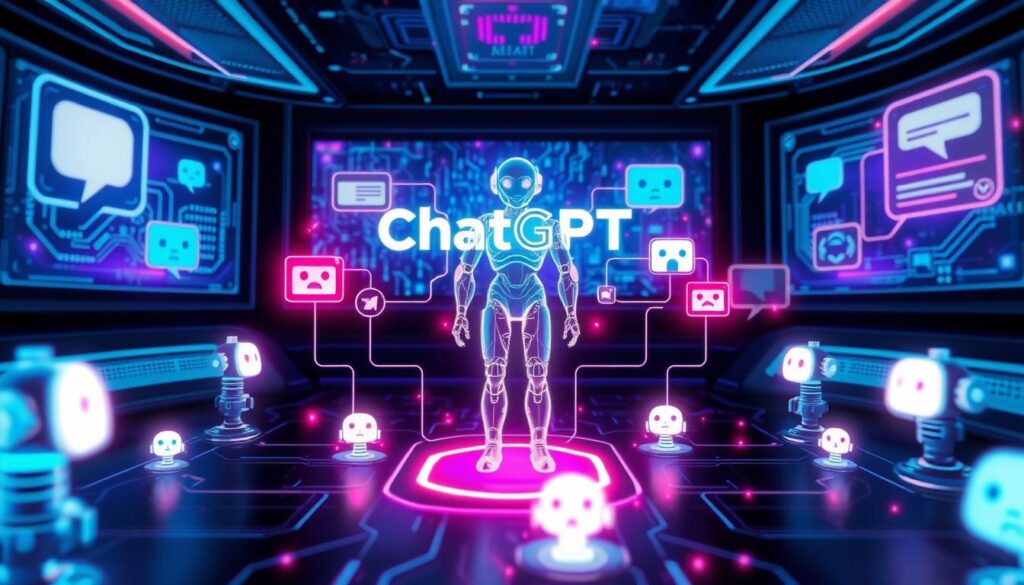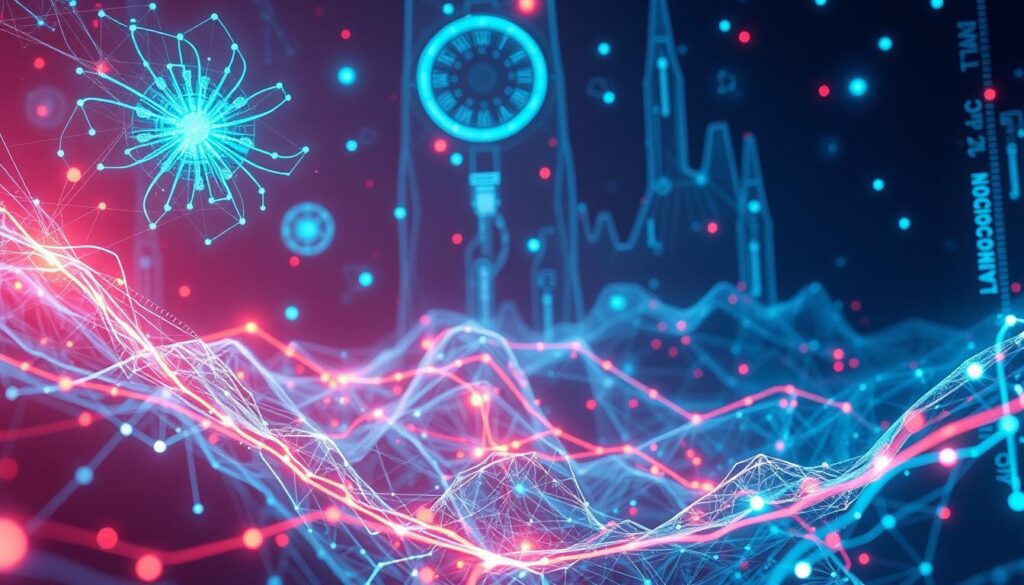“The best way to predict the future is to invent it.” – Alan Kay. This quote is very relevant in the world of technology, especially in conversational AI. The rise of AI and chatbots has changed how businesses talk to customers. With ChatGPT, knowing the differences between chatbots is key for companies wanting to improve customer service and make communication smoother.
Traditional chatbots use rules and basic NLP to work. But they often can’t understand the context well1. OpenAI’s ChatGPT, launched in November 2022, is a big step forward. It uses the GPT-3 model for free-form conversations on many topics, offering a deeper interaction1.
Both tools aim to automate customer chats, but they have different abilities. Knowing these differences helps businesses choose the right tool for their needs. This choice can make a big difference in how well a company serves its customers.
Key Takeaways
- ChatGPT is a recent advancement in conversational AI, launched in November 2022.
- Traditional chatbots focus on rules and basic NLP techniques, which limits their effectiveness.
- ChatGPT utilizes cutting-edge technology to engage in conversations across virtually any subject.
- Over 80% of competitors are currently using chatbots in their operations.
- 56% of consumers prefer text interactions over phone calls for customer service.
Introduction to Chatbots

The Introduction to chatbots shows how they’ve grown from simple programs to smart AI tools. They started in the 1960s and have come a long way. Now, they’re key in tech progress. Chatbots are software that talks like humans and does tasks on many platforms and in different languages.
They work by following rules and scripts, making them good for certain tasks2. They’re fast to set up, helping businesses talk to customers right away. But, they need updates to keep working well2.
Today, chatbot technology lets businesses help customers with simple questions and problems2. They’re great in places like hotels, banks, and online shops where people often need help. With the internet growing, we want chatbots that can have deeper talks, like ChatGPT.
ChatGPT is different because it can change how it talks based on what’s happening3. This shows we want chatbots that feel more like real people.
Understanding ChatGPT

ChatGPT is a cutting-edge chatbot made by OpenAI. It stands out because it uses ChatGPT technology for responses that feel like talking to a person. It was launched in November 2022 and uses the GPT-3.5 and GPT-4 models4.
This chatbot is trained on huge amounts of data. This helps it understand context well, making conversations better across many topics. It can adapt, understand context, speak many languages, and keep learning, marking a big step in AI3.
ChatGPT is used in many fields like hospitality, banking, and healthcare. It’s good at answering questions clearly and coherently. Companies use it to improve content, save money, and offer more personalized service4.
However, making a custom ChatGPT chatbot can be hard. You need technical skills, it needs regular updates, and there are costs for using its API3. Still, ChatGPT is great for many tasks, from creating content to helping with job searches.
How Does a Chatbot Work?
Chatbots are fascinating because they can understand and respond to what we say. They start by listening to what we type or say. Then, they figure out what we mean and give us answers.
There are different types of chatbots, each with its own way of working. Some chatbots use rules to answer questions. They look for specific words and patterns in what we say. This makes them good at answering common questions, like those in customer service5.
Other chatbots use advanced tech like AI. They can understand what we mean better and give more interesting answers. These AI chatbots learn from our conversations, getting better over time6.
As more people talk to businesses online, chatbots have become very important. They help meet the changing needs of customers. This shows how crucial chatbots are in today’s customer service56.
How Does ChatGPT Work?
ChatGPT uses ChatGPT mechanics that combine deep learning and natural language processing. It was launched by OpenAI on November 30, 2022. It quickly became known for its ability to write like a human and help users in many ways7.
It started with the GPT-3.5 model but now uses GPT-4 and GPT-4o. These updates make it better at handling complex questions and giving answers on many topics8.
The tech behind it is a multi-layered Transformer architecture. It starts by breaking down what you say into smaller parts for analysis. Each part gets a special weight, helping the model focus on the most important words.
With layers of Transformer blocks working together, ChatGPT can understand complex conversations. This is a big step up from old chatbots9.
ChatGPT is powered by generative AI and trained on over 500 billion tokens. This huge training set helps it grasp language and relationships well. It’s great at keeping conversations going, answering tough questions, and even helping with coding and writing9.
Types of Chatbots
Chatbots have grown a lot, leading to many types for different needs. The main types of chatbots are rule-based, AI, and generative chatbots. Each has special skills and uses.
Rule-based Chatbots
Rule-based chatbots work with set rules and patterns. They use scripts to talk to users. Their answers are limited to certain words or phrases.
These bots are great for making customer support faster and more consistent10.
AI Chatbots
AI chatbots, like ChatGPT, use machine learning to understand and respond like humans. They learn and get better over time. This makes them change how we talk to customers and learn new things10.
Generative Chatbots
Generative chatbots, like ChatGPT, use advanced machine learning for flexible talks. They get the context and give smart answers in many situations. This helps them handle customer support, solve problems, and analyze data well10.
What is the difference between chatbot and ChatGPT?
The world of digital talk has big differences between chatbot and ChatGPT. Chatbots follow rules and scripts, but ChatGPT uses deep learning for smarter talks2. Chatbots are good for simple chats, but ChatGPT shines in complex talks2.
ChatGPT needs lots of data to learn, unlike chatbots2. Also, ChatGPT takes a lot of computer power to train, unlike chatbots that can start fast2. ChatGPT talks like a person, making it great for creating content and personal chats2.
Comparative Analysis of Capabilities
Traditional chatbots and advanced models like ChatGPT show big differences. Traditional chatbots use set scripts, limiting their responses and understanding. ChatGPT, on the other hand, can have deeper conversations, making interactions more engaging.
Conversational Depth
ChatGPT excels in conversational depth thanks to its advanced algorithms. It understands context and gives detailed answers. Traditional chatbots, while helpful, can’t match this, leaving users feeling stuck.
This gap is a key topic in chatbot analysis. It shows how important it is to keep improving chat technology.
Flexibility
Looking at flexibility, ChatGPT is way ahead. It can handle many different questions without strict rules. This makes it better for users, as it can handle more situations.
While some AI chatbots are flexible, they can’t compare to ChatGPT. The capabilities comparison between these systems helps developers and businesses make better choices.
Adaptability and Contextual Understanding
Chatbots’ ability to adapt is key to their success. Traditional chatbots stick to set rules, limiting their flexibility. They struggle to handle different questions well.
ChatGPT, on the other hand, is more adaptable. It needs fewer rules, making it better at answering a variety of questions. It even gives responses that feel like they come from a real person11.
Contextual understanding is also vital. ChatGPT can understand complex conversations, including jokes and sarcasm12. This makes its answers more relevant and satisfying for users. Yet, it faces issues like biases and limits in certain tasks12.
Use Cases for Chatbots vs. ChatGPT
It’s key for businesses to know the difference between use cases for chatbots and ChatGPT. Chatbots handle simple tasks like answering common questions or helping with booking. They are great for companies wanting to improve customer service without spending a lot.
ChatGPT use cases are for more complex tasks. It can offer detailed support, create content, and help in education. ChatGPT’s advanced abilities make it perfect for businesses needing deeper conversations with their clients.
Knowing when to use chatbots versus ChatGPT helps businesses meet their needs. This choice depends on how complex the interactions need to be. Companies should pick the right tool for their customer service goals.
Choosing the Right Solution for Your Business
When picking chatbots for your business, knowing what you need is key. You must think about how complex the user interactions are and your budget. Traditional chatbots are limited because they only give answers based on set rules and keywords. This can make the user experience less than ideal13.
ChatGPT, however, uses AI to understand and answer many different questions. It offers personalized talks and keeps the conversation interesting.
Studies show that 67% of users found ChatGPT understood their questions fully. This greatly improves the business application of chatbots14. ChatGPT can also come up with new answers based on what it has learned. This makes it better than old chatbots, especially when you need unique interactions.
The growth in AI and NLP means businesses can find better solutions. These solutions can get better over time and make interactions more personal. By knowing what each system can do, businesses can choose the best fit for their needs.
Conclusion
ChatGPT and chatbots have key differences that affect how they help businesses and customers. ChatGPT is great at creating creative and flexible responses. This makes it useful in many situations15. Traditional chatbots, however, stick to set rules, which limits their ability to have deep conversations.
This change in chatbot tech is exciting for the future of AI in customer service. Chatbot AI can now offer support in many languages and tailor responses to what users like. This makes customers happier1516. More companies are looking into these AI tools to make their services better and meet different customer needs.
Businesses need to think about what they really need before choosing a chatbot. Personalization is key in both ChatGPT and traditional chatbots. It makes interactions more meaningful and helps businesses work better1516. By picking the right chatbot, companies can improve how they connect with customers now and in the future.
FAQ
What is the primary difference between a chatbot and ChatGPT?
How have chatbots evolved over time?
What are the main types of chatbots?
How does ChatGPT work differently from traditional chatbots?
What are some common use cases for chatbots?
What should businesses consider when choosing between a chatbot and ChatGPT?
Can ChatGPT provide a more human-like conversation experience?
What limitations do traditional chatbots have compared to ChatGPT?
Source Links
- ChatGPT vs Traditional Chatbots: Core Differences
- What is the difference between chat gpt and chatbot? | Blog
- AI Chatbot or ChatGPT: Which Is Better? Ultimate Guide
- What Is ChatGPT? Everything You Need to Know | TechTarget
- How do chatbots work | The ultimate guide for 2024
- What is a chatbot? + How they work
- What is ChatGPT? How the world’s most popular AI chatbot can benefit you
- Everything you need to know about ChatGPT
- How does ChatGPT work? | Zapier
- Chat AI vs ChatGPT: Spot the Difference!
- ChatGPT Chatbots vs. Traditional Chatbots – Which is the best?
- How Does ChatGPT Handle Contextual Understanding?
- Chatbot vs ChatGPT: Understanding the Differences & Features
- ChatGPT vs. Traditional Chatbots: A Comparative Analysis
- Chatbot AI Vs ChatGPT Comparison | Restackio
- Chatbotapp.AI Vs ChatGPT Comparison | Restackio







